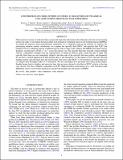Files in this item
Line profiles of cores within clusters. II. Signatures of dynamical collapse during high-mass star formation
Item metadata
| dc.contributor.author | Smith, R.J. | |
| dc.contributor.author | Shetty, R. | |
| dc.contributor.author | Beuther, H. | |
| dc.contributor.author | Klessen, R.S. | |
| dc.contributor.author | Bonnell, I.A. | |
| dc.date.accessioned | 2014-09-25T15:31:01Z | |
| dc.date.available | 2014-09-25T15:31:01Z | |
| dc.date.issued | 2013-07-01 | |
| dc.identifier | 151171398 | |
| dc.identifier | 168febfc-1a10-4dd0-9d63-eecc06a97438 | |
| dc.identifier | 84879022857 | |
| dc.identifier.citation | Smith , R J , Shetty , R , Beuther , H , Klessen , R S & Bonnell , I A 2013 , ' Line profiles of cores within clusters. II. Signatures of dynamical collapse during high-mass star formation ' , Astrophysical Journal , vol. 771 , no. 1 , 24 . https://doi.org/10.1088/0004-637X/771/1/24 | en |
| dc.identifier.issn | 0004-637X | |
| dc.identifier.uri | https://hdl.handle.net/10023/5504 | |
| dc.description | R.J.S, R.S, and R.S.K. acknowledge support from the DFG via the SPP 1573 Physics of the ISM (grants SM321/1-1, KL 1358/14-1, and SCHL 1964/1-1). | en |
| dc.description.abstract | Observations of atomic or molecular lines can provide important information about the physical state of star-forming regions. In order to investigate the line profiles from dynamical collapsing massive star-forming regions (MSFRs), we model the emission from hydrodynamic simulations of a collapsing cloud in the absence of outflows. By performing radiative transfer calculations, we compute the optically thick HCO+ and optically thin N2H+ line profiles from two collapsing regions at different epochs. Due to large-scale collapse, the MSFRs have large velocity gradients, reaching up to 20 km s-1 pc-1 across the central core. The optically thin lines typically contain multiple velocity components resulting from the superposition of numerous density peaks along the line of sight. The optically thick lines are only marginally shifted to the blue side of the optically thin line profiles, and frequently do not have a central depression in their profiles due to self-absorption. As the regions evolve, the lines become brighter and the optically thick lines become broader. The lower-order HCO+ (1-0) transitions are better indicators of collapse than the higher-order (4-3) transitions. We also investigate how the beam sizes affect profile shapes. Smaller beams lead to brighter and narrower lines that are more skewed to the blue in HCO+ relative to the true core velocity, but show multiple components in N2H+. High-resolution observations (e.g., with Atacama Large Millimeter Array) can test these predictions and provide insights into the nature of MSFRs. | |
| dc.format.extent | 12 | |
| dc.format.extent | 921063 | |
| dc.language.iso | eng | |
| dc.relation.ispartof | Astrophysical Journal | en |
| dc.subject | Line: profiles | en |
| dc.subject | Stars: formation | en |
| dc.subject | Stars: massive | en |
| dc.subject | QB Astronomy | en |
| dc.subject | QC Physics | en |
| dc.subject.lcc | QB | en |
| dc.subject.lcc | QC | en |
| dc.title | Line profiles of cores within clusters. II. Signatures of dynamical collapse during high-mass star formation | en |
| dc.type | Journal article | en |
| dc.contributor.sponsor | Science & Technology Facilities Council | en |
| dc.contributor.institution | University of St Andrews. School of Physics and Astronomy | en |
| dc.identifier.doi | 10.1088/0004-637X/771/1/24 | |
| dc.description.status | Peer reviewed | en |
| dc.identifier.grantnumber | ST/J001651/1 | en |
This item appears in the following Collection(s)
Items in the St Andrews Research Repository are protected by copyright, with all rights reserved, unless otherwise indicated.

